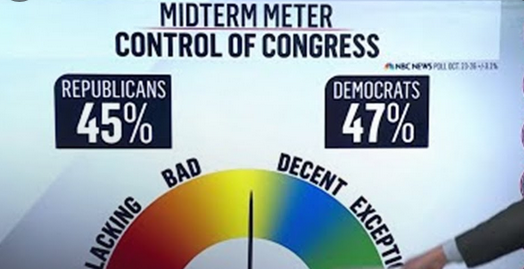Photos: YouTube
If victory in congressional redistricting is defined as guaranteeing control of the House, the latest cycle could be considered something of a draw. Under new congressional maps, both Democrats and Republicans have viable paths to a House majority in coming years, though this is in large measure due to fairer maps drawn by commissions or courts rather than line drawing in states where politicians controlled the pen.
To be sure, Democrats are still likely to lose their House majority in 2022 given this year’s unforgiving midterm dynamics. But if they do, new maps at least give them some reasonable paths to winning it back in future cycles. Likewise, if Republicans do take back the House in 2022, they may well find their new majority uncomfortably tenuous.
However, an important caveat: While neither party is permanently locked out of being able to win a House majority, that doesn’t mean the new maps are fair. On balance, partisan gerrymandering continues to skew maps in favor of Republicans, making the path to a majority harder for Democrats than it would be otherwise. This gerrymandering, moreover, largely comes at the expense of communities of color, especially in the South.
And line drawing may not yet be over for this cycle. In an age of highly polarized politics where having control of Congress can feel existential, a number of states may decide to redraw maps mid-decade if gerrymanders need shoring up or changes to the judiciary or law remove a key watchdog.
The Republican path
For Republicans, the road to a House majority starts with their continued dominance in the seat-rich South, the country’s most populous and fastest-growing region. Since the southern realignment of the 1990s and early 2000s, the South has become a critical anchor for the GOP’s hunt for a House majority. Before the southern realignment, Republicans had been held to under 200 seats in every House election after 1956.
At the beginning of this cycle, Republicans had firm control of redistricting in all of the South except Virginia, where a new bipartisan process would be used, and Louisiana, where Republicans were just shy of a veto-proof legislative majority. As in past cycles, they used that power aggressively to increase their advantages in the region. By further skewing maps in large states like Texas, Georgia, and Florida, Republicans were able to create an additional seven Republican-leaning districts and are now favored to win a whopping 70 percent of the region’s 155 seats, up from an already commanding 66 percent before maps were redrawn. In no other region of the country are Republicans favored to win as many — or as large a percentage of — seats. But it could have been even worse for Democrats: if state courts in North Carolina hadn’t ordered a redraw of a wildly gerrymandered congressional map, Republican dominance of the region would have been even more complete.
All told, factoring in the six Democratic-leaning swing districts in the region, new maps in the South give Republicans the potential to win up to 114 seats, just over half the number needed for a majority. Most of these districts, moreover, are not just Republican, but solidly so because of a concerted Republican strategy to eliminate competitive districts. After redistricting, fewer than 1 in 10 Trump districts in the South is competitive, a far lower percentage than most of the nation.
The next most important region for Republicans is the Midwest and Great Plains, where they controlled the map-drawing pen in 6 of the region’s 12 states. Republicans also benefited in a seventh state — Wisconsin — when the state supreme court drew maps after a legislative deadlock but largely left in place last decade’s pro-Republican gerrymander, reasoning that any court-drawn map should limit changes. (Another two heavily Republican states, North Dakota and South Dakota, have only a single congressional district and did not redistrict.)
Altogether, redistricting in the Midwest and Great Plains resulted in 62 districts that Republicans have a chance to win, including 43 safe districts. However, new maps in the Midwest and Great Plains are not quite as favorable for Republicans as old ones. Due to fairer redistricting in Michigan under the state’s new independent redistricting commission, as well as an aggressive Democratic gerrymander in Illinois, the number of Trump districts in the region fell by six, largely offsetting GOP gains in the South.
In the rest of the country, Republicans had little control over redistricting, making it harder for the party to engineer sure paths to a majority.
In the Mountain states, the country’s least populous region, maps in all but one state were drawn either by commissions or under Democratic control. (The one exception was Utah, where Republicans drew a gerrymandered map. In addition, heavily Republican Wyoming has only a single seat.) Maps in the region give Republicans a chance to win between 17 and 22 seats, depending on election dynamics. But in the end, Republicans saw no net increase in seats from the region — though it remains to be seen whether a risky Democratic effort to maximize seats in Nevada could backfire to the benefit of Republicans in a future election cycle.
Likewise, in the heavily populated and heavily Democratic Northeast and Pacific West, Republicans did not control line drawing in a single state. While new maps in the two regions give Republicans the potential to win between 20 and 40 seats in total, only 20 are safe seats that Republicans can count on if the election environment were to shift to being strongly pro-Democratic.
However, Republicans did score one significant victory in the Northeast when state courts in New York struck down the gerrymandered congressional map passed by Democrats, ordering it replaced with a more evenly balanced one drawn by a special master. The effect was to make three Democratic districts competitive, whereas the original map had none. Indeed, if Republicans have a path to a majority, they can thank courts and commissions that drew two-thirds of all competitive Biden districts nationwide and 9 of 11 of the most competitive. Without these districts, the Republican path to a majority would be considerably more difficult.
In the end, redistricting provided a reasonable but complicated path to a GOP House majority. To win it, Republicans must hold all 208 districts in new maps that Donald Trump would have won in the last presidential election plus at least some of the 30 districts that Joe Biden narrowly carried that year. That likely will not be hard in 2022 given strongly pro-Republican midterm dynamics, but it could prove quite a bit more challenging in future cycles if the expected swing toward Republicans in 2022 in Biden districts is only a cyclical blip rather than a longer-term realignment.
The Democratic path
Democrats have a very different path to a majority — one that is in some ways easier and in some ways harder than that of Republicans.
On the positive side from the perspective of Democrats, they start the hunt for a House majority with considerably more safe seats than Republicans. While new maps contain 178 districts that Trump won in 2020 by eight or more points (a rough proxy for a safe seat), they contain 197 districts that Biden won by that margin — just 21 seats shy of a House majority.
These safe districts are concentrated in the Northeast and Pacific West, two heavily Democratic regions where now 116 of the 127 Democratic-leaning districts are strongly Biden districts. But Democrats also emerged from the redistricting cycle with 41 strongly Biden seats in the South as well as 40 elsewhere in the country. This large block of solid Biden seats gives Democrats a significant anchor for their efforts to win the House barring a complete electoral meltdown or large, unexpected voter realignments.
But Democrats saw efforts to build a secure path to a majority stymied when state courts struck down Democratic gerrymanders in New York and Maryland and ordered them withdrawn. Conversely, Democrats also lost opportunities, at least for this election cycle, as a result of a state court decision in Ohio allowing a pro-GOP gerrymander to remain in place for the 2022 midterms. Likewise, federal courts put a pause on Voting Rights Act litigation in Alabama, Louisiana, and Georgia that could have resulted in the creation of three additional Black opportunity districts that likely would have seen the election of Democrats.
Still, maps give Democrats multiple roads to a House majority this decade. The most straightforward one lies in the 30 districts in new maps that Biden carried by less than eight percentage points in 2020. If Democrats won all or most of these districts (not out of the question in a good Democratic election cycle), they would end up with roughly the same number of seats they hold in the current House without needing to capture a single Trump district. Alternatively, Democrats could build a pathway to a majority — or even an expanded majority — by capturing some share of the 30 districts that Trump won by less than eight percentage points in 2020.
But if on paper Democrats seem to have more routes than Republicans to a majority, there are just as many challenges. Democrats’ biggest risk is that many of the competitive Biden districts are not just competitive but highly competitive. Indeed, of the 30 narrowly Biden districts, his median margin of victory was a slim 4.7 percentage points. With even relatively modest coalitional shifts, many of these seats could easily slip out of Democrats’ reach — and not just in Republican wave years. If, for example, Latino or white suburban voters were to drift toward Republicans on a long-term basis, many of these districts could become hard for Democrats to win. And though it is far too early to draw definite conclusions about long-term trends, there are already some potentially worrying signals for Democrats of just such possible coalitional shifts, particularly among Latinos.
In sum, the good news for Democrats is that they can secure a House majority simply by winning the 227 districts in new maps that Biden carried in 2020. And even if they lose some of those districts, they have an alternative path to a majority in the 30 newly configured districts that Trump won by relatively narrow margins in that election, many of which are in suburbs that have been steadily trending toward the party. But while Democrats potentially have more paths to a majority, they have little room for error. It would take only a small shift to put many districts that Biden narrowly won out of reach for House Democrats. Conversely, because competitive Trump districts are at the edge of being noncompetitive, they would need a much greater shift to put them in play.
In the end, this decade’s maps are not nearly as fair or competitive as they could be. But at the same time, thanks largely to commissions and courts, neither party has a decisive long-term advantage in the battle for control of the House. That, at some level, is a small if not completely satisfactory victory for democracy.
By Michael Li and Chris Leaverton\Brennan Center








